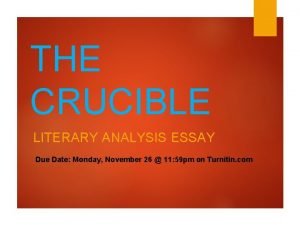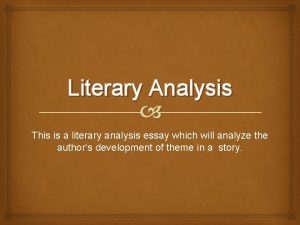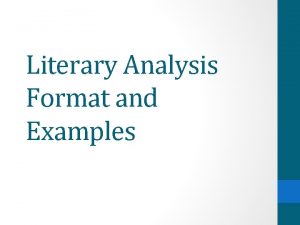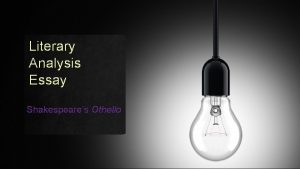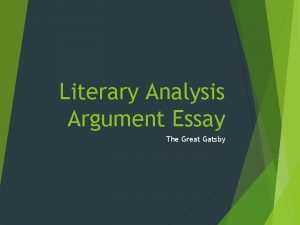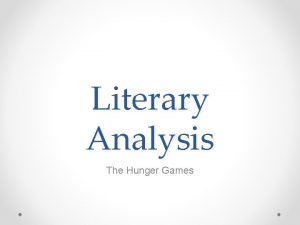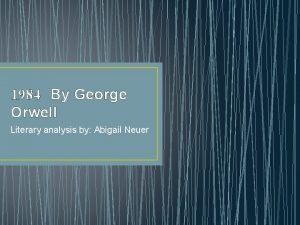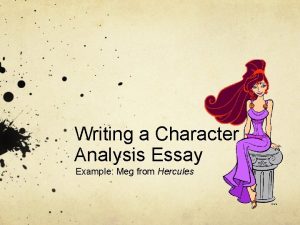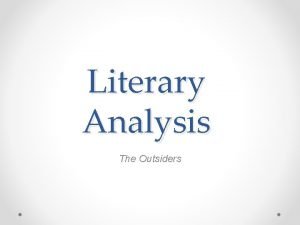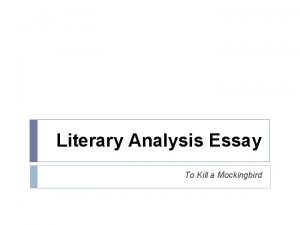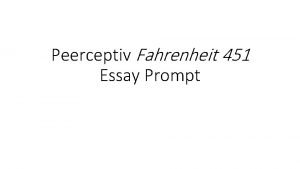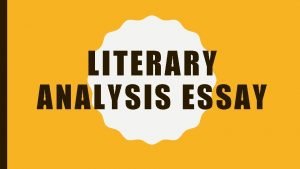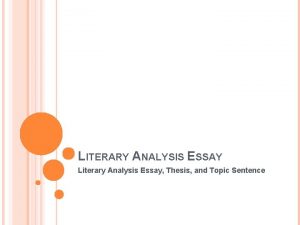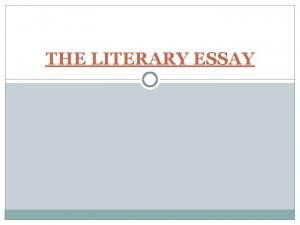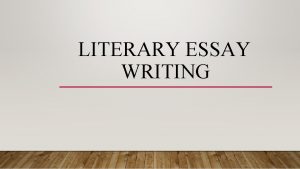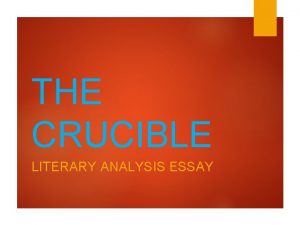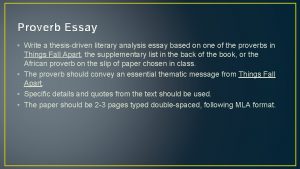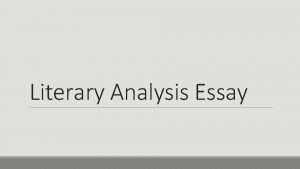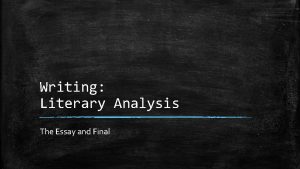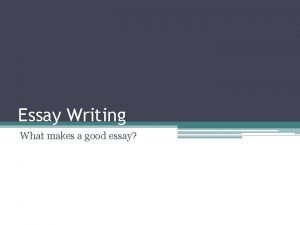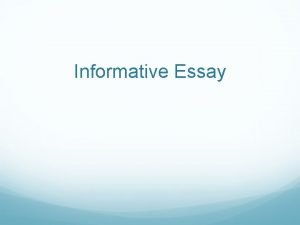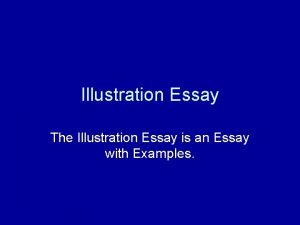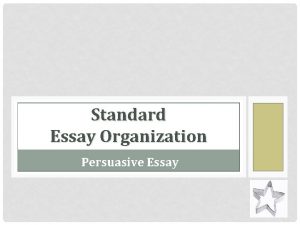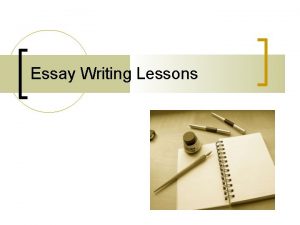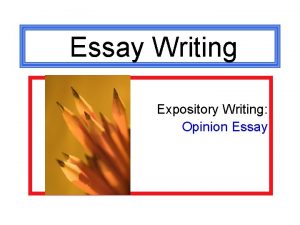Literary Analysis WHAT IT IS The Literary Essay

























- Slides: 25

Literary Analysis

WHAT IT IS… The Literary Essay is an insightful, critical interpretation of a literary work. WHAT IT IS NOT… It is not a summary of plot, character or other elements of fiction in any given literary work.

PURPOSE Carefully examine and evaluate a work of literature or an aspect of a work of literature. Do so by breaking down components of the piece.

1. ANSWER THE QUESTION HOW DOES KURT VONNEGUT USE SATIRE TO CONVEY THEME IN “HARRISON BERGERON”? Identify theme you will focus on. What characteristics of satire did he use to accomplish that?

2. OUTLINE INTRODUCTION BODY CONCLUSION

INTRODUCTION Must include the author and title of the work as well as an explanation of theme to be discussed. Essential background may include setting, an introduction of main characters, etc. The thesis goes in this paragraph usually at the end. Because thesis sometimes sounds tacked on, make special attempts to link it to the sentence that precedes it by building on a key word or idea.

The introduction should include the following: Hook, Author, Title, Main Characters, A Short Summary, Thesis Hook: The beginning sentences of the introduction that catch the reader’s interest. Ways of beginning creatively are on next slide identify the work of literature being discussed name the author briefly present the issue that the body of your essay will more fully develop (your thesis)

A) Creative Opening/Hook: the beginning sentences of the introduction that catch the reader’s interest. Ways of beginning creatively include the following: 1) A startling fact or bit of information Example: Nearly two hundred citizens were arrested as witches during the Salem witch scare of 1692. Eventually nineteen were hanged, and another was pressed to death (Marks 65). 2) A snatch of dialogue between two characters Example: “It is another thing. You [Frederic Henry] cannot know about it unless you have it. ” “ Well, ” I said. “If I ever get it I will tell you [priest]. ” (Hemingway 72). With these words, the priest in Ernest Hemingway’s A Farewell to Arms sends the hero, Frederic, in search of the ambiguous “it” in his life. 3) A meaningful quotation (from the book you are analyzing or another source) Example: “To be, or not to be, that is the question” {3. 1. 57}. This familiar statement expresses the young prince’s moral dilemma in William Shakespeare’s tragedy Hamlet, Prince of Denmark. 4) A universal idea Example: The terrifying scenes a soldier experiences on the front probably follow him throughout his life—if he manages to survive the war. 5) A rich, vivid description of the setting Example: Sleepy Maycomb, like other Southern towns, suffers considerably during the Great Depression. Poverty reaches from the privileged families, like the Finches, to the Negroes and “white trash” Ewells, who live on the outskirts of town. Harper Lee paints a vivid picture of life in this humid Alabama town where tempers and bigotry explode into conflict.

THESIS – answer the prompt The thesis statement tells your reader what to expect: it is a restricted, precisely worded declarative sentence that states the purpose of your essay -- the point you are trying to make. • Gwendolyn Brooks‟s 1960 poem “The Ballad of Rudolph Reed” demonstrates how the poet uses the conventional poetic form of the ballad to treat the unconventional poetic subject of racial intolerance. The fate of the main characters in Antigone illustrates the danger of excessive pride. The imagery in Dylan Thomas‟s poem “Fern Hill” reveals the ambiguity of humans‟ relationship with nature. Typically, thesis statement falls at the end of your introductory paragraph.

Most Important!!!! The most important thing to understand is that your thesis statement MUST contain two parts: the topic and an opinion about that topic.

A Thesis is not an Announcement of the Subject Announcement: Not a Thesis This paper will attempt to explain why the boys split into two hostile groups. Thesis Statement The boys split into two hostile groups because of their inherent violent nature

A Thesis Statement is Not a Fact A thesis makes a judgment or interpretation. There’s no way to spend a whole paper supporting a statement that needs no support. Fact: Not a Thesis 1. Jack felt anger towards Ralph and eventually formed his own group. 2. Bellevue High School’s colors are Blue and Gold.

A Good Thesis… u is restricted. It deals with restricted, bite-size issues rather than issues that would require a lifetime to discuss intelligently. The more restricted thesis, the better the chances are for supporting it fully.

Answers the prompt in one sentence Identify the item – name of story/author Add strong verb – Give opinion of topic – In “A Worn Path, ” Eudora Welty creates a fictional character in Phoenix Jackson whose determination, faith, and cunning illustrate the indomitable human spirit. Note that the work, author, and character to be analyzed are identified in this thesis statement. The thesis relies on a strong verb (creates). It also identifies the element of fiction that the writer will explore (character) and the characteristics the writer will analyze and discuss (determination, faith, cunning).

“The Third and Final Continent” exhibits characteristics recurrent in writings by immigrants: tradition, adaptation, and identity. Note how thesis statement classifies the form of the work (writings by immigrants) and identifies the characteristics of that form of writing (tradition, adaptation, and identity) that the essay will discuss.

SAMPLE PATTERNS FOR THESES ON LITERARY WORKS 1. In (title of work), (author) (illustrates, shows) (aspect) (adjective). Example: In “Barn Burning, ” William Faulkner shows the characters Sardie and Abner Snopes struggling for their identity. 2. In (title of work), (author) uses (one aspect) to (define, strengthen, illustrate) the (element of work). Example: In “Youth, ” Joseph Conrad uses foreshadowing to strengthen the plot.

3. In (title of work), (author) uses (literary device) to (accomplish, develop, illustrate, strengthen) (element of work). Example: In “The Masque of the Red Death, ” Poe uses the symbolism of the stranger, the clock, and the seventh room to develop theme of death. 4. (Author) (shows, develops, illustrates) theme of _____ in the (play, poem, story). Example: Flannery O’Connor illustrates theme of the effect of the selfishness of the grandmother upon the family in “A Good Man is Hard to Find. ” 5. (Author) develops his character(s) in (title of work) through his/her use of language. Example: John Updike develops his characters in “A & P” through his use of figurative language.

BODY 1) Topic sentence (what this paragraph will discuss, how it will prove your thesis) 2) Context for the quote - Who says it? - What’s happening in the text when they say it? 3) Quote from the text (cited appropriately) 4) Analysis of the quote: How does it prove your thesis? Explanation of how quote/example demonstrates a facet of your thesis. 5) Closing sentence (wrap up the paragraph to effectively transition to the next paragraph)

1) Topic Sentence: the first sentence of a body paragraph. It identifies one aspect of thesis and states a primary reason why the major thesis is true. Example: When he first appears in the novel, Sidney Carton is a loveless outcast who sees little worth in himself or in others. 2) Textual Evidence: first give background information about scene or character you are going to quote. Then use quotation marks and citations. Example: When Carlton and Darnay first meet at the tavern, Carlton tells him, “I care for no man on this earth, and no man cares for me” (Dickens 105).

3) Commentary: your explanation and interpretation of the textual evidence. § Commentary tells the reader what the author of the text means or how the textual evidence proves the topic sentence. (Helpful hint: In your body paragraph, you should have twice as much commentary as textual evidence. In other words, for every sentence of textual evidence, you should have at least two sentences of commentary. ) Example: Carton makes this statement as if he were excusing his rude behavior to Darnay. Carton, however, is only pretending to be polite, perhaps to amuse himself. With this seemingly off-the-cuff remark, Carton reveals a deeper cynicism and his emotional isolation.

4) Transitions: words or phrases that connect or “hook” one idea to the next, both between and within paragraphs. Examples: Finally, in the climax. . . Another example: . . . Later in the story. . . In contrast to this behavior…Not only. . . but also. . . Furthermore. . . 5) Clincher/Concluding Sentence: last sentence of the body paragraph. It concludes the paragraph by tying the textual evidence and commentary back to thesis. Example: Thus, before Carton experiences love, he is able to convince himself that the world has no meaning.

CONCLUSION This paragraph should begin by echoing your major thesis without repeating the words exactly. 1) Reflect on how your essay relates to the book as a whole 2) Evaluate how successful the author is in achieving his or her goal or message 3) Make predictions 4) Connect back to your creative opening 5) Give your opinion of the novel’s value or significance

FORMATTING v In the upper left-hand corner of the first page, list your name, instructor's name, the course, and the date. v Be sure to use double-spaced text. v Microsoft Sans Serif , Verdana or Calibri, font size 12 v Label each page, including page 1, with your last name and page number

CITATIONS After the lead in to quote make sure you quote the author. For short stories like Harrison Beregon, in parenthesis put the author’s last name and page number. “That sure was a doozy” (Vonnegut 4).

STRONG VERBS acknowledges adds asks blames Clarifies confirms confronts compares critiques defends defines demonstrates describes encourages endorses entertains explores features furnishes gives identifies illustrates invites lists names offers praises presents provides proposes recommends shows suggests supports teaches tells traces
 Body paragraph for the crucible
Body paragraph for the crucible Conclusion clincher
Conclusion clincher The first day edward p jones summary
The first day edward p jones summary How to write a hook for a literary analysis essay
How to write a hook for a literary analysis essay Othello literary analysis essay
Othello literary analysis essay The great gatsby literary analysis essay
The great gatsby literary analysis essay Hunger games theme essay
Hunger games theme essay 1984 literary analysis essay
1984 literary analysis essay Characterization essay example
Characterization essay example The outsiders literary analysis
The outsiders literary analysis Macbeth literary essay
Macbeth literary essay To kill a mockingbird literary essay
To kill a mockingbird literary essay Fahrenheit 451 journal prompts
Fahrenheit 451 journal prompts Hình ảnh bộ gõ cơ thể búng tay
Hình ảnh bộ gõ cơ thể búng tay Bổ thể
Bổ thể Tỉ lệ cơ thể trẻ em
Tỉ lệ cơ thể trẻ em Chó sói
Chó sói Chụp phim tư thế worms-breton
Chụp phim tư thế worms-breton Chúa yêu trần thế
Chúa yêu trần thế Kể tên các môn thể thao
Kể tên các môn thể thao Thế nào là hệ số cao nhất
Thế nào là hệ số cao nhất Các châu lục và đại dương trên thế giới
Các châu lục và đại dương trên thế giới Công thức tiính động năng
Công thức tiính động năng Trời xanh đây là của chúng ta thể thơ
Trời xanh đây là của chúng ta thể thơ Mật thư tọa độ 5x5
Mật thư tọa độ 5x5
